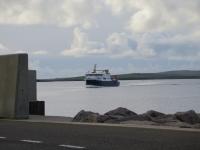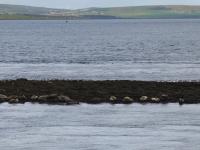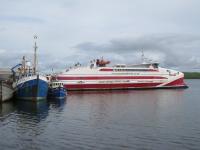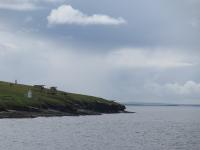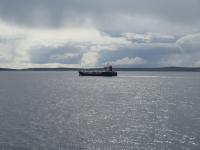Profile
Blog
Photos
Videos
This morning started wet, so after brekkie I implemented Plan B and drove to Stromness to have a look at the Stromness Museum. It's quite small but packed with lots of stuff. Stromness itself is a little unusual. Like many old towns, its main street is fairly narrow with many bends - however two-way traffic is still permitted.
Leaving Stromness, it was still raining but there was blue sky ahead, so feeling optimistic I reverted to Plan A and paid a visit to Skara Brae. This is a Neolithic Stone Age village - the most complete in Europe - that was populated 5,100 years ago for about 600 years. It was discovered in 1850 when a massive storm removed the soil in which it was buried.
One of four sites that are referred to as The Heart of Neolithic Orkney, the buildings are remarkably well preserved. Made of stone, they also contained the original stone furniture. All but one building were houses and each had the same layout. In the centre is a hearth. Opposite the entrance is a stone sideboard in which they presumably kept knick knacks. Then on both sides are stone beds. The other building has the central hearth but no beds. It seems likely it was a workshop. One building is covered with a grass roof, hence it looks like it's out of Teletubbyland.
Alongside Skara Brae is Skaill House. This was built in 1620 by Bishop George Graham. In 1850, it was the home of the local Laird William Watt, who owned the land where Skara Brae was discovered. He played a large part in the initial excavation.
I next moved on to another Heart of Neolithic Orkney site, The Ring of Brodgar. This is Britain's third largest stone circle and the northernmost circle henge. It's 104 metres (341 ft) in diameter and comprised of 60 stones, of which 27 have survived. It is an impressive sight.
A mile further along the road are The Standing Stones of Stenness - the third of the Heart of Neolithic Orkney sites. It is believed this may be the oldest henge site in the British Isles, which has led to the theory that Orkney started the cult of stone circle construction. Sadly in 1814, Captain Mackay, who owned the surrounding farmland, decided to destroy the stones as locals were trespassing on his land by using the stones in rituals. He managed to destroy The Odin stone, which was pierced by a hole through which couples would hold hands to confirm their engagement, a second stone and toppled a third before he was halted by outraged locals. The surviving stones make an impressive sight, situated as they are between Lochs Harray and Stenness.
Next to the stones is the Barnhouse Neolithic Settlement, the remains of a Stone Age village, though less extensive than Skara Brae.
The Final Heart of Neolithic Orkney site can only be seen by a pre-booked tour, and I had a little time before my tour, so I made my way to Unstan Chambered Cairn. This is another Neolithic Tomb, but not one of the Big Four. From the outside, this is a grassed covered mound. To enter the tomb I had to get on my hands and knees. Once inside I could stand up and admire just how well built it was. The roof is not original, and as there are a couple of skylights, would make a great home for a Teletubby.
I then made my way to Maeshowe, the final of the Big Four Heart of Neolithic Orkney sites. This is another grass covered tomb - or is it? Sarah was our very entertaining guide. To enter, we had to bend double to get through the 10 metre long entrance. Once in the main chamber, Sarah pointed out that in the corners are four Standing Stones, so it could have been created around an existing henge. The long entrance tunnel is lined with two standing stones that have been laid on their sides. She also told us that 3 weeks either side of the Winter Solstice, at sunset the entrance to the chamber is angled such that the sun lights up the interior. Therefore, could it have had a ceremonial purpose? Or is it a Teletubby home?
The interior has many runes carved into the stone. These were carved by a group of Norsemen who were caught out in snowstorm and broke through the roof to take shelter. All the runes have been translated. They also carved a picture of a dragon. The next people to break through the roof were the Victorians, hence the current roof was built by them.
My sightseeing completed for the day, I made for Kirkwall to the The Harbour Fry, a Fish and Chip Restaurant where I had a lovely meal of, you've guessed it, haggis, chips, cheese and gravy.
Today we covered 77 miles.
- comments





